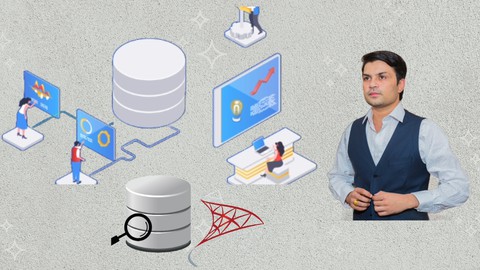
Data-driven Industry Applications with LabVIEW and MySQL
Data-driven Industry Applications with LabVIEW and MySQL, available at $49.99, has an average rating of 4.15, with 14 lectures, 1 quizzes, based on 10 reviews, and has 38 subscribers.
You will learn about Create your own database or interact with existing databases Learn basics of LabVIEW Write complex SQL queries across multiple tables Build a web app using MySQL This course is ideal for individuals who are People who want to develop programs in LabVIEW with the highest levels of quality based on good practices and development standards with LabVIEW and who seek to achieve work or business with the best technology companies in the world. It is particularly useful for People who want to develop programs in LabVIEW with the highest levels of quality based on good practices and development standards with LabVIEW and who seek to achieve work or business with the best technology companies in the world.
Enroll now: Data-driven Industry Applications with LabVIEW and MySQL
Summary
Title: Data-driven Industry Applications with LabVIEW and MySQL
Price: $49.99
Average Rating: 4.15
Number of Lectures: 14
Number of Quizzes: 1
Number of Published Lectures: 14
Number of Published Quizzes: 1
Number of Curriculum Items: 15
Number of Published Curriculum Objects: 15
Original Price: ₹799
Quality Status: approved
Status: Live
What You Will Learn
- Create your own database or interact with existing databases
- Learn basics of LabVIEW
- Write complex SQL queries across multiple tables
- Build a web app using MySQL
Who Should Attend
- People who want to develop programs in LabVIEW with the highest levels of quality based on good practices and development standards with LabVIEW and who seek to achieve work or business with the best technology companies in the world.
Target Audiences
- People who want to develop programs in LabVIEW with the highest levels of quality based on good practices and development standards with LabVIEW and who seek to achieve work or business with the best technology companies in the world.
Laboratory Virtual Instrument Engineering Workbench (LabVIEW): is a system-design platform and development environment for a visual programming language from National Instruments.
The graphical language is named “G”; not to be confused with G-code. LabVIEW originally developed the G dataflow language, LabVIEW is commonly used for data acquisition, instrument control, and industrial automation on a variety of operating systems (OSs), including Microsoft Windows as well as various versions of Unix, Linux, and macOS.
LabVIEW integrates the creation of user interfaces (termed front panels) into the development cycle. LabVIEW programs-subroutines are termed virtual instruments (VIs). Each VI has three components: a block diagram, a front panel, and a connector pane. The last is used to represent the VI in the block diagrams of others, called VIs. The front panel is built using controls and indicators. Controls are inputs: they allow a user to supply information to the VI. Indicators are outputs: they indicate, or display, the results based on the inputs given to the VI. The back panel, which is a block diagram, contains the graphical source code. All the objects placed on the front panel will appear on the back panel as terminals. The back panel also contains structures and functions which perform operations on controls and supply data to indicators. The structures and functions are found on the Functions palette and can be placed on the back panel. Collectively controls, indicators, structures, and functions are referred to as nodes. Nodes are connected to one another using wires, e.g., two controls and an indicator can be wired to the addition function so that the indicator displays the sum of the two controls. Thus, a virtual instrument can be run as either a program, with the front panel serving as a user interface, or, when dropped as a node onto the block diagram, the front panel defines the inputs and outputs for the node through the connector pane. This implies each VI can be easily tested before being embedded as a subroutine into a larger program.
Why Learn MySQL
Consistently ranked the most in-demand skill in recent employer surveys, SQL is a fantastic way to increase your income and boost your professional development. So many companies today use MySQL, including Twitter, Uber, Airbnb, Dropbox, Github, Kickstarter, Udemy, Slack, and many others. Unsure about the difference between SQL and MySQL? MySQL is the most popular open-source SQL database out there, so it’s an excellent choice to begin your learning journey. We’ll talk a lot more about the difference between SQL and MySQL in the course, but 95% of what you learn about MySQL in this course will apply to other databases such as Postgres, Oracle, and Microsoft SQL Server.
Course Curriculum
Chapter 1: Introduction
Lecture 1: Introduction
Chapter 2: Basics of LabVIEW
Lecture 1: Introduction to Mathematical Expressions
Lecture 2: Introduction to Logical Expressions
Lecture 3: Introduction Comparison Block
Lecture 4: Introduction to LabVIEW Structures
Chapter 3: Introduction to DBMS
Lecture 1: Database Management System
Lecture 2: SQL using APEX Oracle
Lecture 3: SQL using APEX Oracle Hands-on
Lecture 4: SQL using APEX Oracle Lec-2
Lecture 5: SQL using APEX Oracle Lec-3
Chapter 4: My SQL using LabVIEW
Lecture 1: My SQL Part-1
Lecture 2: My SQL Part-2
Lecture 3: Create Table
Lecture 4: Retrieve Data
Chapter 5: Quiz
Instructors
-
Salim Khan
LabVIEW Instructor
Rating Distribution
- 1 stars: 0 votes
- 2 stars: 1 votes
- 3 stars: 2 votes
- 4 stars: 3 votes
- 5 stars: 4 votes
Frequently Asked Questions
How long do I have access to the course materials?
You can view and review the lecture materials indefinitely, like an on-demand channel.
Can I take my courses with me wherever I go?
Definitely! If you have an internet connection, courses on Udemy are available on any device at any time. If you don’t have an internet connection, some instructors also let their students download course lectures. That’s up to the instructor though, so make sure you get on their good side!
You may also like
- Best Yoga Instruction Courses to Learn in March 2025
- Best Stress Management Courses to Learn in March 2025
- Best Mindfulness Meditation Courses to Learn in March 2025
- Best Life Coaching Courses to Learn in March 2025
- Best Career Development Courses to Learn in March 2025
- Best Relationship Building Courses to Learn in March 2025
- Best Parenting Skills Courses to Learn in March 2025
- Best Home Improvement Courses to Learn in March 2025
- Best Gardening Courses to Learn in March 2025
- Best Sewing And Knitting Courses to Learn in March 2025
- Best Interior Design Courses to Learn in March 2025
- Best Writing Courses Courses to Learn in March 2025
- Best Storytelling Courses to Learn in March 2025
- Best Creativity Workshops Courses to Learn in March 2025
- Best Resilience Training Courses to Learn in March 2025
- Best Emotional Intelligence Courses to Learn in March 2025
- Best Time Management Courses to Learn in March 2025
- Best Remote Work Strategies Courses to Learn in March 2025
- Best Freelancing Courses to Learn in March 2025
- Best E-commerce Strategies Courses to Learn in March 2025






















